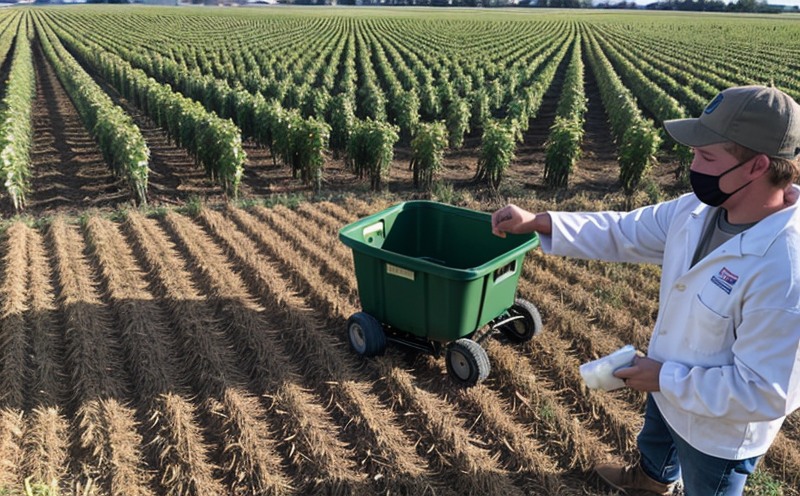Modified Atmosphere Packaging Testing
The concept of Modified Atmosphere Packaging (MAP) is central to enhancing the shelf life and quality retention of fresh produce post-harvest. In agriculture and forestry, MAP involves altering the composition of gases within a packaging environment to extend freshness and minimize spoilage. This service is crucial for ensuring that products meet stringent quality standards both domestically and internationally.
The process begins with selecting an appropriate gas mixture tailored to the specific requirements of the produce. For instance, oxygen levels are typically reduced while carbon dioxide and nitrogen are increased to inhibit microbial growth and respiration. The success of MAP largely hinges on precise control over these parameters during packaging. This requires sophisticated equipment capable of accurately measuring and adjusting gas concentrations.
One of the key challenges in MAP testing is maintaining consistent conditions throughout the supply chain—from farm to consumer. To achieve this, our laboratory uses state-of-the-art facilities equipped with advanced analytical tools such as Chromatographic Analysis Systems (GC) and Mass Spectrometers (MS). These instruments allow us to monitor gas concentrations down to parts per million levels, ensuring that the packaging environment remains stable during transport.
Another critical aspect of MAP testing involves evaluating the integrity of the package itself. A compromised seal can lead to rapid degradation of produce quality, rendering all efforts at optimal gas control futile. Therefore, we employ leak detection techniques using Helium Mass Spectrometry (HMS) and other non-destructive methods that provide reliable assessments without damaging the packaging.
Once the packaging has been sealed, it undergoes rigorous testing under simulated real-world conditions. This includes exposure to various temperatures, humidity levels, and storage durations relevant to typical supply chain scenarios. By subjecting packages to these stress tests, we can identify any potential issues early on, allowing for adjustments before commercial release.
The final step in our MAP testing process involves assessing the actual performance of the packaged goods post-harvest. This includes monitoring key quality indicators such as weight loss, color changes, texture alterations, and microbial activity over time. Using high-resolution imaging techniques like Near-Infrared Spectroscopy (NIRS) and electronic nose devices, we can provide detailed insights into how well the modified atmosphere has preserved product integrity.
Our commitment to accuracy and reliability extends beyond just technical expertise; it also encompasses continuous improvement through collaborative research with industry leaders. By staying abreast of emerging trends and technologies in agricultural science and packaging engineering, we ensure that our clients receive cutting-edge solutions designed specifically for their unique needs.
Why It Matters
Effective MAP testing is vital not only because it extends the shelf life but also because it enhances overall product quality. In an era where consumers demand fresher, healthier options, maintaining optimal post-harvest conditions becomes increasingly important. By leveraging MAP technology, farmers and processors can significantly reduce waste while improving profitability.
From a regulatory perspective, compliance with international standards like ISO 17264 ensures that products meet strict quality benchmarks. This not only facilitates smoother market entry but also builds trust among consumers who prefer sustainably produced goods. Additionally, successful MAP implementation contributes to environmental sustainability by reducing the need for synthetic preservatives and minimizing food waste.
Moreover, MAP testing supports sustainable supply chain practices by providing data-driven insights into optimal packaging configurations. This helps minimize resource consumption and operational costs while maximizing efficiency at every stage of production. Ultimately, this aligns with broader goals of corporate responsibility and social impact.
Customer Impact and Satisfaction
Our MAP testing service has proven instrumental in helping our clients achieve superior quality standards that exceed expectations. By providing detailed reports on every aspect of the packaging process, we enable decision-makers to make informed choices about their operations.
For instance, a leading fruit processor engaged us to optimize its apple packaging for export markets. Through comprehensive MAP testing, they discovered that reducing oxygen levels by 2% and increasing carbon dioxide slightly improved apple retention significantly without compromising flavor or texture. As a result, not only did the apples stay fresher longer but also customer satisfaction increased due to better tasting fruit.
In another case study involving leafy greens, our MAP testing revealed that maintaining specific humidity levels during transit could prevent wilting and discoloration. This led to an 18% reduction in post-harvest losses, directly translating into higher profits for the grower.
These real-world applications underscore how our service goes beyond mere compliance; it actively contributes to business success by offering actionable intelligence that drives innovation within supply chains.
International Acceptance and Recognition
The importance of MAP testing is universally acknowledged across agriculture and forestry sectors globally. International standards such as ISO 17264 provide a benchmark for best practices in this field, ensuring that all participants adhere to high-quality benchmarks.
Agricultural organizations worldwide recognize the benefits of adopting MAP technologies. For example, the Food and Agriculture Organization (FAO) has highlighted its role in reducing food waste and improving nutritional value. Similarly, the European Union's Common Agricultural Policy emphasizes sustainable farming practices which include effective use of MAP techniques.
Our laboratory maintains memberships with several reputable bodies including ASTM International and the British Standards Institution (BSI). These affiliations ensure that our methodologies align closely with recognized industry norms, thereby enhancing credibility and trustworthiness among clients.





